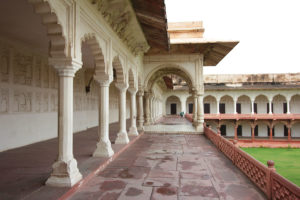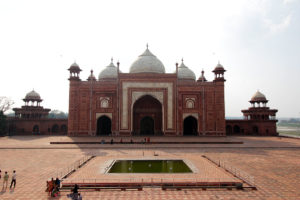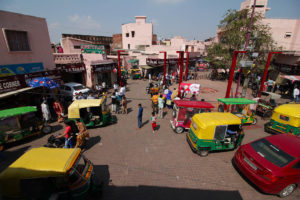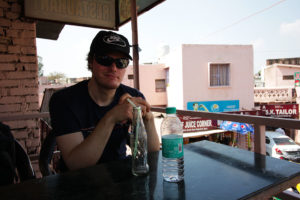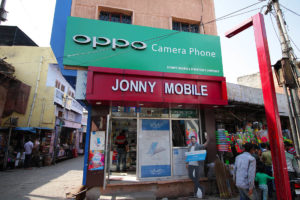
The most beautiful Tomb in the World
From the Series: Stories from India
From March 9th to March 13th
Our second train ride in India is a bit different than the first. Why? Because someone sits on our reserved seats.
Well, the fact is that I could not determine where exactly we would be sitting at the time of booking. However, the system tries to select the places of the same booking as close to each other as possible. In this case, it was close enough for 12 seats between Dom and me, haha.
He has 42 and I 30. Both of them side berths. Since someone is in my reserved place, and apparently someone in Doms too, we just sit somewhere else and look out of the window. The conductor seems to have no problem when he checks our tickets and we can stay here for the rest of the ride.
Since it is quite early in the morning – departure at 06:15 clock – we doze a bit, while the landscape at the window next to us passes by. Time and time again, sellers are hurrying through the aisles, offering tea, coffee and snacks.
I remember that I was feeling so sick that morning, but I do not remember why.
Having arrived at the railway station of Agra, we take a tucktuck into the city. It takes us to our accommodation, the “Ray of Maya” guesthouse. The manager welcomes us very friendly. As usual in India, our passports are copied and we have to write some of our personal details in a book. Accommodations in India are required to obtain certain information from guests, as the Indian government appears to retain the overview of the tourists and ensure that no one is illegally staying in the country. Thus for example, the visa is always copied from the passport.
With the personal details, Dom and I – apart from our names – mostly do not take it so exactly, hehe. Our addresses in Switzerland are constantly changing. Once Dom lives at the Nussbaumgartenstrasse 67. Then suddenly in number 99 and so on. All sorts of ideas arise there and as of now nobody ever asked a second time and hopefully nobody tried to find the addresses on google, haha.
The city of Agra is located on one of the tourist routes in North India. In this city stands the famous Taj Mahal, one of the most remarkable buildings in the world. So we would visit it tomorrow, on Friday. But then something put a spike in our wheels: the Taj Mahal is always closed on Fridays. Of course only for non-Muslims, which Dom and I – apparently obviously – are. I ask myself again and again what the criterion is.
In the net, I once read that one should be able to denounce the statement of faith- the Shahada – to be able to go through as a Muslim during a check.
I’ve never tried that before. Would be worth a try I guess.
In the afternoon, Dom feels strange and suddenly appears to be very worn out. He is tired and falls asleep. Meanwhile, I read a little and surf the net. For Dom it is rather unusual to be ill. He is usually health itself, hahaha. He has a fever and the acting chief orderly and Captain initiates a treatment. Meanwhile, he keeps Susanne up to date, as she worries about her beloved one. Of course we hope that no doctor’s visit is necessary. Not that the doctors in India are inevitably “worse” than those in Switzerland, but the hygienic conditions are most likely very different.
I remember that a German doctor told us once at a travel medicine course that doctors in Brazil had much more practical experience in diagnostics than those in Switzerland. And that the country of education is not necessarily decisive for the quality of a doctor.
During the night it rains heavily and when I lie in bed the next morning, I am not sure if we would visit the Red Fort today, which is open today, Friday, March 10th. But the Neocitran from yesterday seems to have worked well and Dom looks much, much better this morning 😉 The decision lies with him and he decides to go on the tour! Good. In the morning it is still quite cool and the driving wind blowing through the tucktuck does not make it warmer.
The driver takes us to the Red Fort and we visit it. The mighty Mogul stronghold is one of the most beautiful in all of India. The ruler Akbar began in 1565 with the construction of the massive fort of red sandstone on the banks of the Yamuna river.
The fort was primarily used for military purposes, but Shah Jahan turned it into a palace, which would later become his gold-plated prison for eight years after his son Aurangzeb had seized power.
The colossal double walls of the fort are over 20 m high and 2.5 km long. Originally the Yamuna flowed directly along the eastern edge of the fort, and the rulers had their own ghats there for bathing. In the fort is a labyrinth of buildings that form a city in the city; There are even large subterranean areas. However, many buildings were destroyed by Nadir Shah, the Marathen, the Jats, and the British, who used the fort as a garrison. Even today a large part of the fort is used by the military and is not accessible to visitors.
After visiting the Red Fort, we don’t do much more. In the hotel room we rest and watch a few films.
On Saturday we can finally see the Taj Mahal! We are very curious about this building as it is one of the most famous in the world. The Mogul ruler Shah Jahan built the Taj Mahal in memory of his third wife, Mumtaz Mahal, who died in 1631 at the birth of her 14th child.
Mumtaz’s death broke the heart of the ruler. Supposedly his hair turned grey almost overnight. Construction began in the following year. The complex was completed in 1653; But the main building allegedly has been finished after eight years already. A short time later Shah Jahan was deposed by his son Aurangzeb and imprisoned in the fort.
For the rest of his life, he could only look at his creation through a window. After his death in 1666, Shah Jahan found his last resting-place at Mumtaz ‘side.
A total of 20,000 people from India and Central Asia participated in the construction work, including specialists from the far Europe. They made the exquisite marble walls and decorated the pietra dura (inlays of marble) with thousands of semi-precious stones. The Taj Mahal was appointed World Cultural Heritage in 1983. It still looks as immaculate as it was shortly after its establishment – even though it had to be extensively restored in the early 20th century.
The entrance fee is about 200 rupees for Indians. And foreigners- yes, right – 1000 rupees. Actually, backpacks or bags are not allowed at the site. But neither Dom nor I would like to entrust our backpacks, containing all the cameras and passports, to one of the dealers outside who offer this service. Metal detectors and armed security personnel contribute to the safety of the site.
We are allowed inside with our backpacks. Hundreds of people are here. Of course, we are asked for photos from time to time again. Unfortunately, one of the four minarets surrounding the Taj is wrapped in a scaffold. However, the building is magnificent.
After our visit to the Taj we go back to the hotel. Then we decide to see the building from a different perspective again, namely at sunset. By tucktuck we drive another way to the north side of the building, the back side. Between us and the Taj Mahal lies the river Yamuna and just in time we arrive to see how the last rays of the sun color the building in a slightly reddish tone.
The next morning, Sunday, we walk to the district of Taj Ganj. This quarter is located south of the Taj Mahal and seems to be inhabited by many Muslims. We sit down on the terrace on the first floor of a small restaurant and watch the busy fuss on the square in front of the building. To our surprise, the waiter is an about 11 years old boy, who speaks better English than most of the Indians, we have met so far!
There seems to be a lot going on in this neighborhood and the honking down at the crossroads is incredibly annoying. One can hardly imagine how this must be the whole day to endure, for example, if you live here. People are bound to get tinnitus.
We decide to stroll around the streets of Taj Ganj and look for good opportunities for a picture. We come through small narrow alleys. People everywhere. Some are watching us curiously. Many of them painted their faces with many colors. Why? It is the beginning of the famous Holi festival. An important event for Hindus.
Holi is a Hindu spring festival celebrated in India and Nepal, also known as the “festival of colours” or the “festival of love”. The festival signifies the victory of good over evil, the arrival of spring, end of winter, and for many a festive day to meet others, play and laugh, forget and forgive, and repair broken relationships. People visit family, friends and foes to throw coloured powders on each other, laugh and gossip
On the first day, a fire is lit in the night and a figure of straw is burned in it, a symbol of the demon Holika. Various myths deal with this demon: one of the most famous tales is the following:
The childlike prince Prahlada was to be persuaded by his father to show him all the divine honor, but the boy continued to worship Vishnu only. By various means the king tried to kill his son, but each time Vishnu himself intervened and saved the child. Finally, the king took a trick: his sister Holika, who was protected from the fire by special powers, was to jump into the fire with Prahlada and burn him. But the flames spared the child, and Holika only remained a pile of ashes.
Afterwards, the people celebrate the festival Holi as a reminder of the destruction of the demon. Thus we see everywhere piles of wood, which were placed on the squares and in the streets.
In the evening we return to Taj Ganj to have dinner. The festivities for Holi begin already. And quite loud and in the form of fireworks in the middle of the street. Sounds somehow Indian 😉
Actually, we should have traveled by train to Varanasi on Sunday. However, this trip was canceled. On what grounds we did not know. So we tried to find out why and what we could do about it at the railway station in Agra. Until we were finally standing at a counter in front of an official, it took us some nerves. For a few notorious jostlers simply ran in front of us to demand something from the man behind the glass.
Well, in India there’s no regular queueing. When it is finally our turn, it takes a lot of concentration to figure out what the official is trying to tell us. It is quite noisy at the station and in addition his English does not correspond exactly to a Cambridge standard, haha.
Ultimately, we find out that the train does not actually drive due to technical problems. If he can organize a ticket for tomorrow’s train, we ask. Then he explains something I do not understand. Dom does not seem to understand either. At some point, he turns his computer screen in our direction and there we see on a kind of “Dos” interface that behind every reservation number the word “cancelled” stands.
Now we do not know whether this applies to the train of today or to the one tomorrow. In the end it does not matter, because here we would not achieve anything more. So we go back to the hotel and book the train ride online for Monday. Thank Buddha there are still seats in the AC 2nd Class. A bit comfortable we wanted to have it already on this trip, since it should take 14 hours!
How we were deceived and what happened is to be read in the next post!








